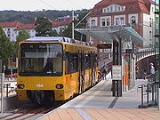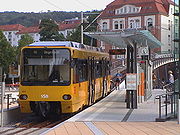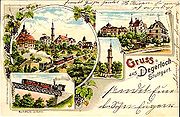
Rack Railway Stuttgart
Encyclopedia


Rack railway
A rack-and-pinion railway is a railway with a toothed rack rail, usually between the running rails. The trains are fitted with one or more cog wheels or pinions that mesh with this rack rail...
in Stuttgart
Stuttgart
Stuttgart is the capital of the state of Baden-Württemberg in southern Germany. The sixth-largest city in Germany, Stuttgart has a population of 600,038 while the metropolitan area has a population of 5.3 million ....
, Germany
Germany
Germany , officially the Federal Republic of Germany , is a federal parliamentary republic in Europe. The country consists of 16 states while the capital and largest city is Berlin. Germany covers an area of 357,021 km2 and has a largely temperate seasonal climate...
. It is the only urban rack railway in Germany.
Affectionately called Zacke (spike) by the residents of Stuttgart, the line was opened on 23 August 1884. It connects the urban districts of Stuttgart South (Marienplatz) and Degerloch (Albplatz). The route runs along the Alte Weinsteige, which was historically the main route to the Filder towns until the Neue Weinsteige was built in 1826.
Over its 2.2 km route the line climbs a height of 205 m (from 260 m to 465 m AMSL
Above mean sea level
The term above mean sea level refers to the elevation or altitude of any object, relative to the average sea level datum. AMSL is used extensively in radio by engineers to determine the coverage area a station will be able to reach...
). The maximum incline on the route is 17.5% (between Liststrasse and Pfaffenweg). On the branch line to the depot of the (old) rack railway yard, the maximum incline is 20.0%. Between the stops at Pfaffenweg and Wielandshöhe there is a view of Stuttgart's city centre.
The rack railway is integrated with the metropolitan railway network of the Stuttgarter Straßenbahnen AG
Stuttgarter Straßenbahnen AG
Stuttgarter Straßenbahnen AG is the principal public transport operating company in the German city of Stuttgart. The SSB operates light rail lines, bus lines, a rack railway, and a funicular railway.- Colour:...
(SSB) as Line 10. At Marienplatz it connects with Stuttgart Stadtbahn
Stuttgart Stadtbahn
The Stuttgart Stadtbahn is a light rail system in Stuttgart, Germany. It is operated by the Stuttgarter Straßenbahnen AG , which also operates the bus systems in that city...
lines U1 and U14 and at Albplatz it connects with lines U5, U6 and U8.
The line is one of two working railway lines that are tourist attraction
Tourist attraction
A tourist attraction is a place of interest where tourists visit, typically for its inherent or exhibited cultural value, historical significance, natural or built beauty, or amusement opportunities....
s in Stuttgart; the other being the Stuttgart funicular railway
Funicular
A funicular, also known as an inclined plane or cliff railway, is a cable railway in which a cable attached to a pair of tram-like vehicles on rails moves them up and down a steep slope; the ascending and descending vehicles counterbalance each other.-Operation:The basic principle of funicular...
that leads to the forest cemetery, and operates as SSB line 20.
The rack railway train includes a wagon at the front or back for transporting bicycles.
History
- 23 August 1884: Opening of the Stuttgart - Degerloch rack railway, the first section of the Filderbahn line, as a narrow gauge steam-operated railway with a Riggenbach system. The Filderbahn Company operated the route from Stuttgart to Degerloch station.
- 1902: Electrification of the rack railway and the adhesionRail adhesionThe term adhesion railway or adhesion traction describes the most common type of railway, where power is applied by driving some or all of the wheels of the locomotive. Thus, it relies on the friction between a steel wheel and a steel rail. Note that steam locomotives of old were driven only by...
routes from Degerloch to Hohenheim and from Möhringen to Vaihingen. Electrification of the rack railway line was delayed by two years due to technical problems. - 1903: Relocation of the passing trackPassing loopA passing loop is a place on a single line railway or tramway, often located at a station, where trains or trams in opposing directions can pass each other. Trains/trams in the same direction can also overtake, providing that the signalling arrangement allows it...
from Haigst to Wielandshöhe. - 1904: Electrical operation begins on the rack railway, steam operation limited to Sunday excursions.
- 1918: Two additional steam engines taken over second-hand from the Swiss BrünigbahnBrünigbahnThe Brünigbahn was, until 31 December 2004, the only narrow gauge railway of the Swiss Federal Railways . On 30 June 2004, the Swiss Federal Council empowered the SBB to sell the Brünigbahn to Luzern–Stans–Engelberg-Bahn , and this company was renamed to Zentralbahn.The Brünigbahn encompasses the...
railway for steam services which had increased due to the war. - 1920: Filderbahn taken over by the city of Stuttgart and its management transferred to the Stuttgarter Straßenbahnen (Stuttgart Tramways).
- 1921: Steam operations ended.
- 1926: All passenger coaches on the rack railway and Filderbahn repainted to SSB liveryLiveryA livery is a uniform, insignia or symbol adorning, in a non-military context, a person, an object or a vehicle that denotes a relationship between the wearer of the livery and an individual or corporate body. Often, elements of the heraldry relating to the individual or corporate body feature in...
. However, to distinguish SSB-owned vehicles from Filderbahn-owned vehicles, the latter provisionally prefixed their vehicle numbers with the letter "F". - 1934: Filderbahn and the rack railway transfer to the ownership of the Stuttgarter Straßenbahnen.
- 1935: First two railcars with 3 axles are delivered, number 101 (in service until 1982) and 102 (scrapped due to damage in 1974).
- 1936: Relocation of the rack railway's Stuttgart terminal station from the valley to Marienplatz to improve transfers to the trams.
- 1937: Motor coachRailcarA railcar, in British English and Australian English, is a self-propelled railway vehicle designed to transport passengers. The term "railcar" is usually used in reference to a train consisting of a single coach , with a driver's cab at one or both ends. Some railways, e.g., the Great Western...
103 was the first vehicle built entirely of steel to be delivered to the SSB. - 1950: Last two coaches of the second generation railcars delivered, number 104 (today a museum railcar) and 105 (dismantled in 1995).
- 1954: Last railcar of the first generation, number 109, is taken out of service.
- 1956: Transfer of trailer(s) from the Filderbahn to the rack railway to handle the increased school traffic. This was however extremely rarely done and then only up to 1965 when the practice was discontinued.
- 1965: Replacement of the old cast ironCast ironCast iron is derived from pig iron, and while it usually refers to gray iron, it also identifies a large group of ferrous alloys which solidify with a eutectic. The color of a fractured surface can be used to identify an alloy. White cast iron is named after its white surface when fractured, due...
bridge (commonly called the Turkish bridge because its manufacturer, Maschinenfabrik EsslingenMaschinenfabrik EsslingenMaschinenfabrik Esslingen , was a German engineering firm that manufactured locomotives, tramways, railway wagons, roll-blocks, technical equipment for the railways, , bridges, steel structures, pumps and boilers.-Founding:...
, originally intended to deliver the bridge to TurkeyTurkeyTurkey , known officially as the Republic of Turkey , is a Eurasian country located in Western Asia and in East Thrace in Southeastern Europe...
.) over the Neue Weinsteige by the present-day reinforced concreteReinforced concreteReinforced concrete is concrete in which reinforcement bars , reinforcement grids, plates or fibers have been incorporated to strengthen the concrete in tension. It was invented by French gardener Joseph Monier in 1849 and patented in 1867. The term Ferro Concrete refers only to concrete that is...
bridge. - 1971: As a result of changes to the track layout at Marienplatz and the construction of the underground station the double-trackedDouble trackA double track railway usually involves running one track in each direction, compared to a single track railway where trains in both directions share the same track.- Overview :...
valley station at Marienplatz was replaced by a single-trackedSingle track (rail)A single track railway is where trains in both directions share the same track. Single track is normally used on lesser used rail lines, often branch lines, where the traffic density is not high enough to justify the cost of building double tracks....
station, half of which is located on the bridge across a water reservoir (later filled in). - 1974: Railcar number 102, recently taken out of service, is paraded in the Stuttgart Shrove Tuesday procession as an attraction.
- 1977: As a result of the rebuilding of the rack railway's Degerloch station, the connecting track to the adhesion railway was lifted and the rack railway became isolated from the rest of the SSB network.
- 1978: Cessation of routine three-coach working.
- 1980: Refurbishing of the complete rack railway track for use with newly commissioned railcars of type ZT4.
- 1982: Introduction of modern ZT4 motor coachesRailcarA railcar, in British English and Australian English, is a self-propelled railway vehicle designed to transport passengers. The term "railcar" is usually used in reference to a train consisting of a single coach , with a driver's cab at one or both ends. Some railways, e.g., the Great Western...
into the metropolitan railway network. Trials on transporting bicycles on the inclined line in a demonstration wagon designed by the company. - 1984: Centenary celebrations and last school run on the traditional rack railway route by motor coach 104 and demonstration car 120.
- 1989: Replacement of the former swinging leaf doors on the ZT4 by appropriate external swing out doors on the DT8.
- 1992: Sale of display car 117 (built 1896) to the Härtsfeld Museum Railway (HMB) in Neresheim. Hitherto it had been displayed by a private collector as a monument. The museum employs it today as narrow gauge passenger vehicle on its own line.
- 1994: Extension of the route at the top of the line to the Albplatz to improve the connexion to the metropolitan railwayStuttgart StadtbahnThe Stuttgart Stadtbahn is a light rail system in Stuttgart, Germany. It is operated by the Stuttgarter Straßenbahnen AG , which also operates the bus systems in that city...
. - 2002: Reopening of the rebuilt terminal and bridge at the entirely redesigned and modernized Marienplatz (6 December).
- 2004: Replacement of the track superstructure; partial laying of a new, slightly narrower rack rail.
External links
- http://www.trampicturebook.de/tram/germany/stuttgar/zacke.htm

